Market Orientation: Analyzing Profitability and Business Strategies
VerifiedAdded on 2021/06/14
|7
|1943
|360
Report
AI Summary
This report explores the significant impact of market orientation on a firm's profitability in the contemporary business environment. It emphasizes the shift from product-oriented to market-oriented strategies, where customer needs are prioritized. The analysis highlights how market orientation increases profitability through higher sales volumes, enhanced customer loyalty, and the ability to offer differentiated services. The report also acknowledges that while market orientation generally boosts profitability, it can sometimes lead to losses if customer desires are pursued without proper cost-benefit analysis. The report underscores the importance of integrating customer insights into strategic planning while maintaining a balanced approach to ensure long-term financial success. The report references several academic articles and studies to support its arguments.
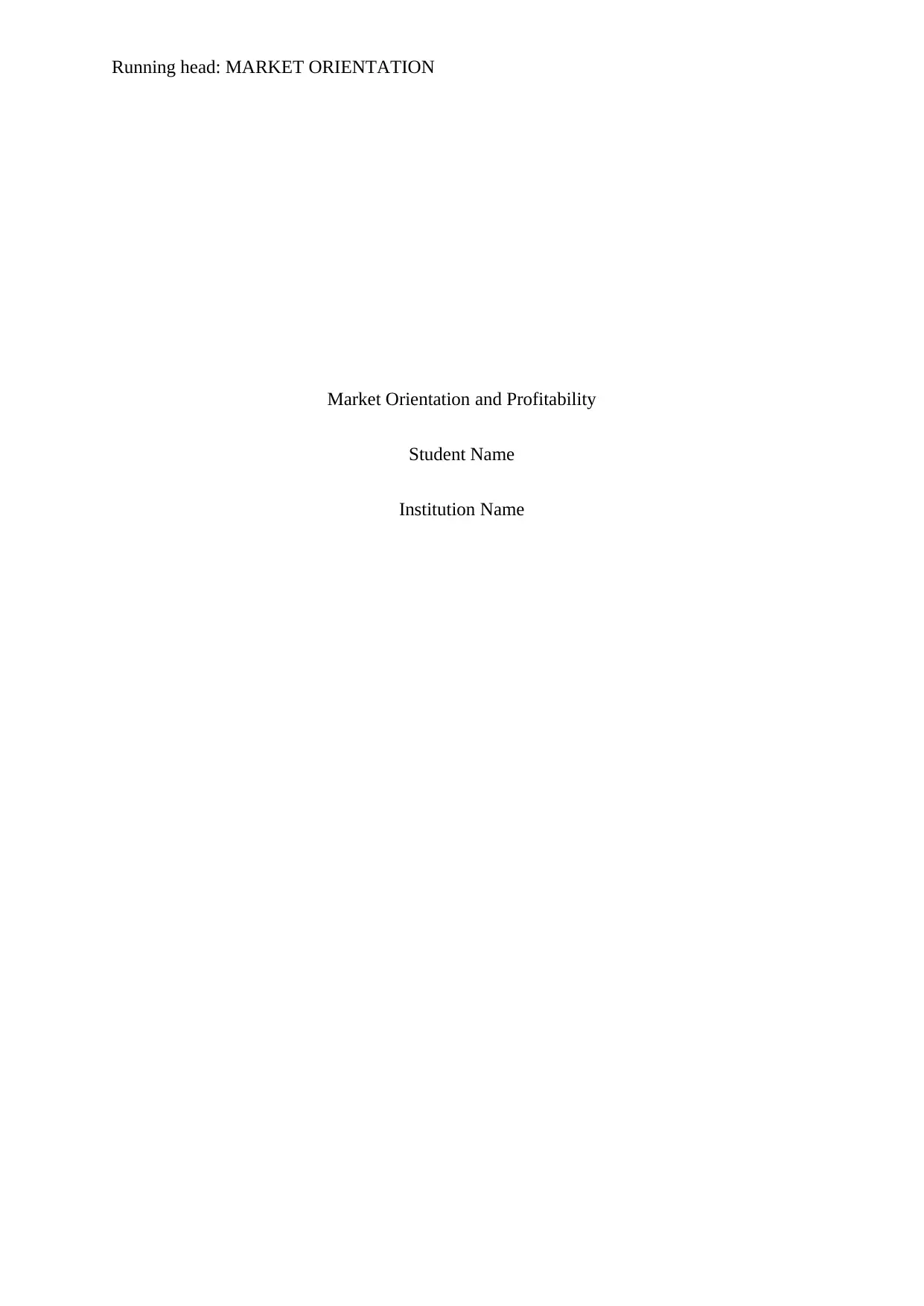
Running head: MARKET ORIENTATION
Market Orientation and Profitability
Student Name
Institution Name
Market Orientation and Profitability
Student Name
Institution Name
Paraphrase This Document
Need a fresh take? Get an instant paraphrase of this document with our AI Paraphraser
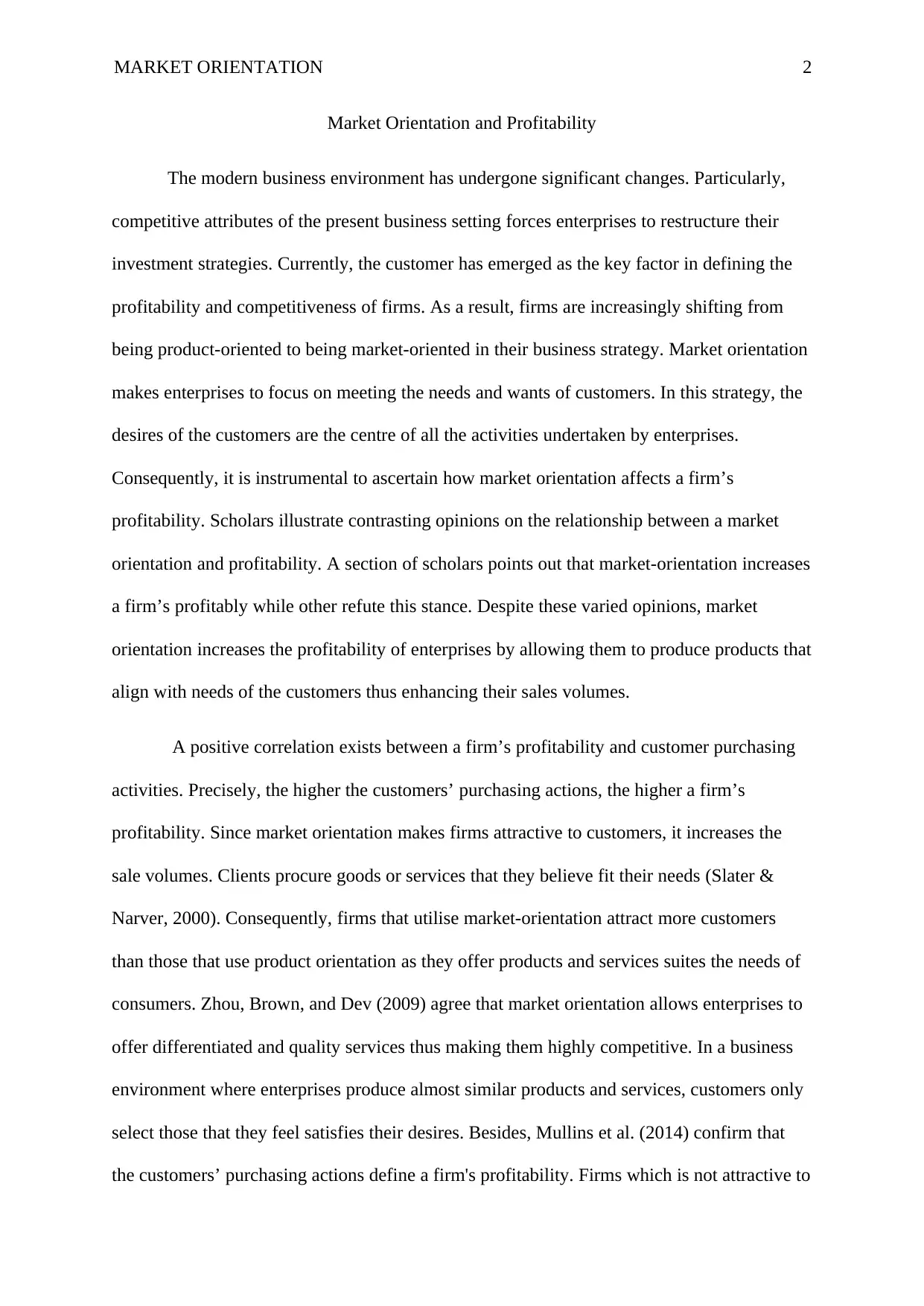
MARKET ORIENTATION 2
Market Orientation and Profitability
The modern business environment has undergone significant changes. Particularly,
competitive attributes of the present business setting forces enterprises to restructure their
investment strategies. Currently, the customer has emerged as the key factor in defining the
profitability and competitiveness of firms. As a result, firms are increasingly shifting from
being product-oriented to being market-oriented in their business strategy. Market orientation
makes enterprises to focus on meeting the needs and wants of customers. In this strategy, the
desires of the customers are the centre of all the activities undertaken by enterprises.
Consequently, it is instrumental to ascertain how market orientation affects a firm’s
profitability. Scholars illustrate contrasting opinions on the relationship between a market
orientation and profitability. A section of scholars points out that market-orientation increases
a firm’s profitably while other refute this stance. Despite these varied opinions, market
orientation increases the profitability of enterprises by allowing them to produce products that
align with needs of the customers thus enhancing their sales volumes.
A positive correlation exists between a firm’s profitability and customer purchasing
activities. Precisely, the higher the customers’ purchasing actions, the higher a firm’s
profitability. Since market orientation makes firms attractive to customers, it increases the
sale volumes. Clients procure goods or services that they believe fit their needs (Slater &
Narver, 2000). Consequently, firms that utilise market-orientation attract more customers
than those that use product orientation as they offer products and services suites the needs of
consumers. Zhou, Brown, and Dev (2009) agree that market orientation allows enterprises to
offer differentiated and quality services thus making them highly competitive. In a business
environment where enterprises produce almost similar products and services, customers only
select those that they feel satisfies their desires. Besides, Mullins et al. (2014) confirm that
the customers’ purchasing actions define a firm's profitability. Firms which is not attractive to
Market Orientation and Profitability
The modern business environment has undergone significant changes. Particularly,
competitive attributes of the present business setting forces enterprises to restructure their
investment strategies. Currently, the customer has emerged as the key factor in defining the
profitability and competitiveness of firms. As a result, firms are increasingly shifting from
being product-oriented to being market-oriented in their business strategy. Market orientation
makes enterprises to focus on meeting the needs and wants of customers. In this strategy, the
desires of the customers are the centre of all the activities undertaken by enterprises.
Consequently, it is instrumental to ascertain how market orientation affects a firm’s
profitability. Scholars illustrate contrasting opinions on the relationship between a market
orientation and profitability. A section of scholars points out that market-orientation increases
a firm’s profitably while other refute this stance. Despite these varied opinions, market
orientation increases the profitability of enterprises by allowing them to produce products that
align with needs of the customers thus enhancing their sales volumes.
A positive correlation exists between a firm’s profitability and customer purchasing
activities. Precisely, the higher the customers’ purchasing actions, the higher a firm’s
profitability. Since market orientation makes firms attractive to customers, it increases the
sale volumes. Clients procure goods or services that they believe fit their needs (Slater &
Narver, 2000). Consequently, firms that utilise market-orientation attract more customers
than those that use product orientation as they offer products and services suites the needs of
consumers. Zhou, Brown, and Dev (2009) agree that market orientation allows enterprises to
offer differentiated and quality services thus making them highly competitive. In a business
environment where enterprises produce almost similar products and services, customers only
select those that they feel satisfies their desires. Besides, Mullins et al. (2014) confirm that
the customers’ purchasing actions define a firm's profitability. Firms which is not attractive to
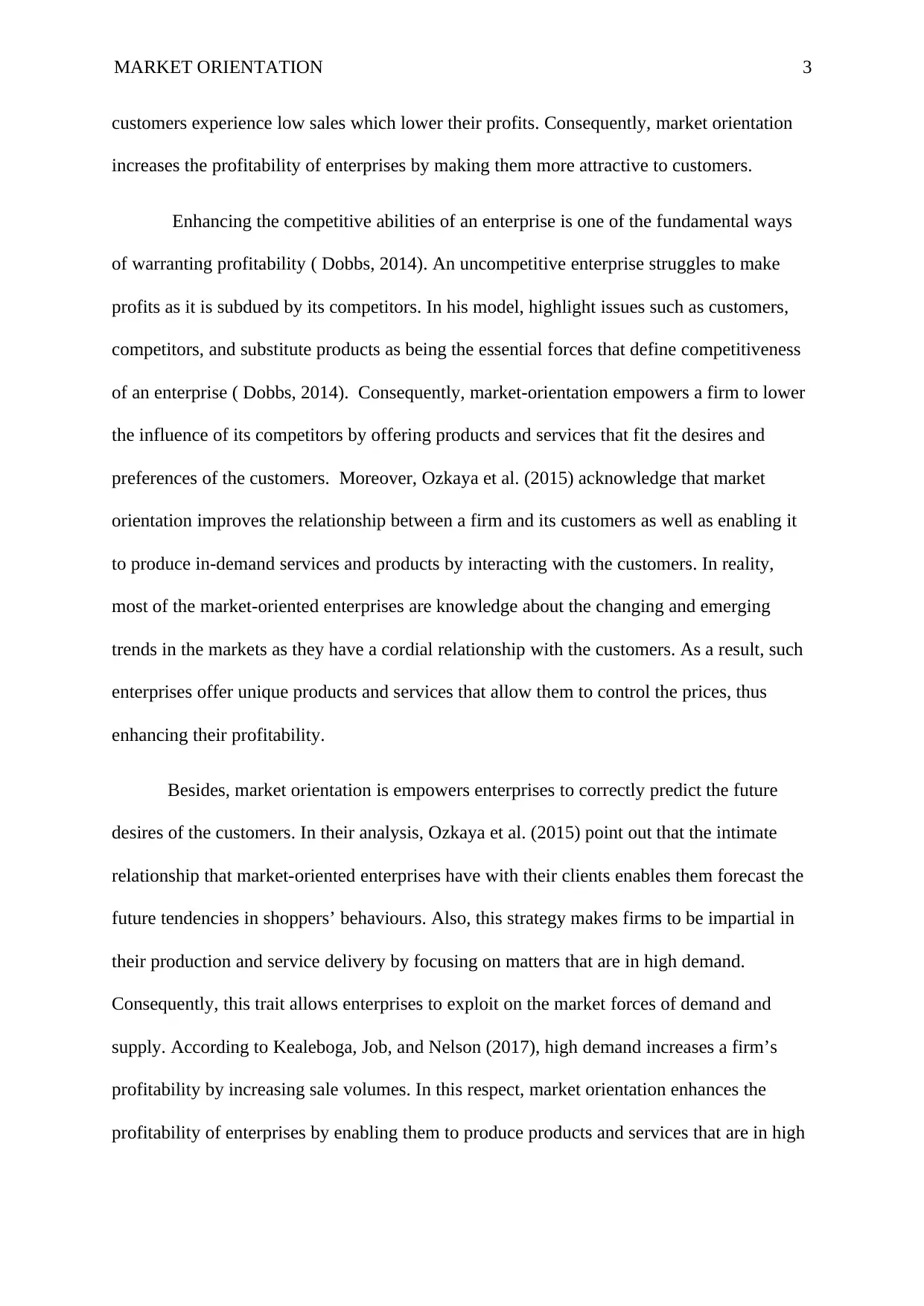
MARKET ORIENTATION 3
customers experience low sales which lower their profits. Consequently, market orientation
increases the profitability of enterprises by making them more attractive to customers.
Enhancing the competitive abilities of an enterprise is one of the fundamental ways
of warranting profitability ( Dobbs, 2014). An uncompetitive enterprise struggles to make
profits as it is subdued by its competitors. In his model, highlight issues such as customers,
competitors, and substitute products as being the essential forces that define competitiveness
of an enterprise ( Dobbs, 2014). Consequently, market-orientation empowers a firm to lower
the influence of its competitors by offering products and services that fit the desires and
preferences of the customers. Moreover, Ozkaya et al. (2015) acknowledge that market
orientation improves the relationship between a firm and its customers as well as enabling it
to produce in-demand services and products by interacting with the customers. In reality,
most of the market-oriented enterprises are knowledge about the changing and emerging
trends in the markets as they have a cordial relationship with the customers. As a result, such
enterprises offer unique products and services that allow them to control the prices, thus
enhancing their profitability.
Besides, market orientation is empowers enterprises to correctly predict the future
desires of the customers. In their analysis, Ozkaya et al. (2015) point out that the intimate
relationship that market-oriented enterprises have with their clients enables them forecast the
future tendencies in shoppers’ behaviours. Also, this strategy makes firms to be impartial in
their production and service delivery by focusing on matters that are in high demand.
Consequently, this trait allows enterprises to exploit on the market forces of demand and
supply. According to Kealeboga, Job, and Nelson (2017), high demand increases a firm’s
profitability by increasing sale volumes. In this respect, market orientation enhances the
profitability of enterprises by enabling them to produce products and services that are in high
customers experience low sales which lower their profits. Consequently, market orientation
increases the profitability of enterprises by making them more attractive to customers.
Enhancing the competitive abilities of an enterprise is one of the fundamental ways
of warranting profitability ( Dobbs, 2014). An uncompetitive enterprise struggles to make
profits as it is subdued by its competitors. In his model, highlight issues such as customers,
competitors, and substitute products as being the essential forces that define competitiveness
of an enterprise ( Dobbs, 2014). Consequently, market-orientation empowers a firm to lower
the influence of its competitors by offering products and services that fit the desires and
preferences of the customers. Moreover, Ozkaya et al. (2015) acknowledge that market
orientation improves the relationship between a firm and its customers as well as enabling it
to produce in-demand services and products by interacting with the customers. In reality,
most of the market-oriented enterprises are knowledge about the changing and emerging
trends in the markets as they have a cordial relationship with the customers. As a result, such
enterprises offer unique products and services that allow them to control the prices, thus
enhancing their profitability.
Besides, market orientation is empowers enterprises to correctly predict the future
desires of the customers. In their analysis, Ozkaya et al. (2015) point out that the intimate
relationship that market-oriented enterprises have with their clients enables them forecast the
future tendencies in shoppers’ behaviours. Also, this strategy makes firms to be impartial in
their production and service delivery by focusing on matters that are in high demand.
Consequently, this trait allows enterprises to exploit on the market forces of demand and
supply. According to Kealeboga, Job, and Nelson (2017), high demand increases a firm’s
profitability by increasing sale volumes. In this respect, market orientation enhances the
profitability of enterprises by enabling them to produce products and services that are in high
⊘ This is a preview!⊘
Do you want full access?
Subscribe today to unlock all pages.

Trusted by 1+ million students worldwide
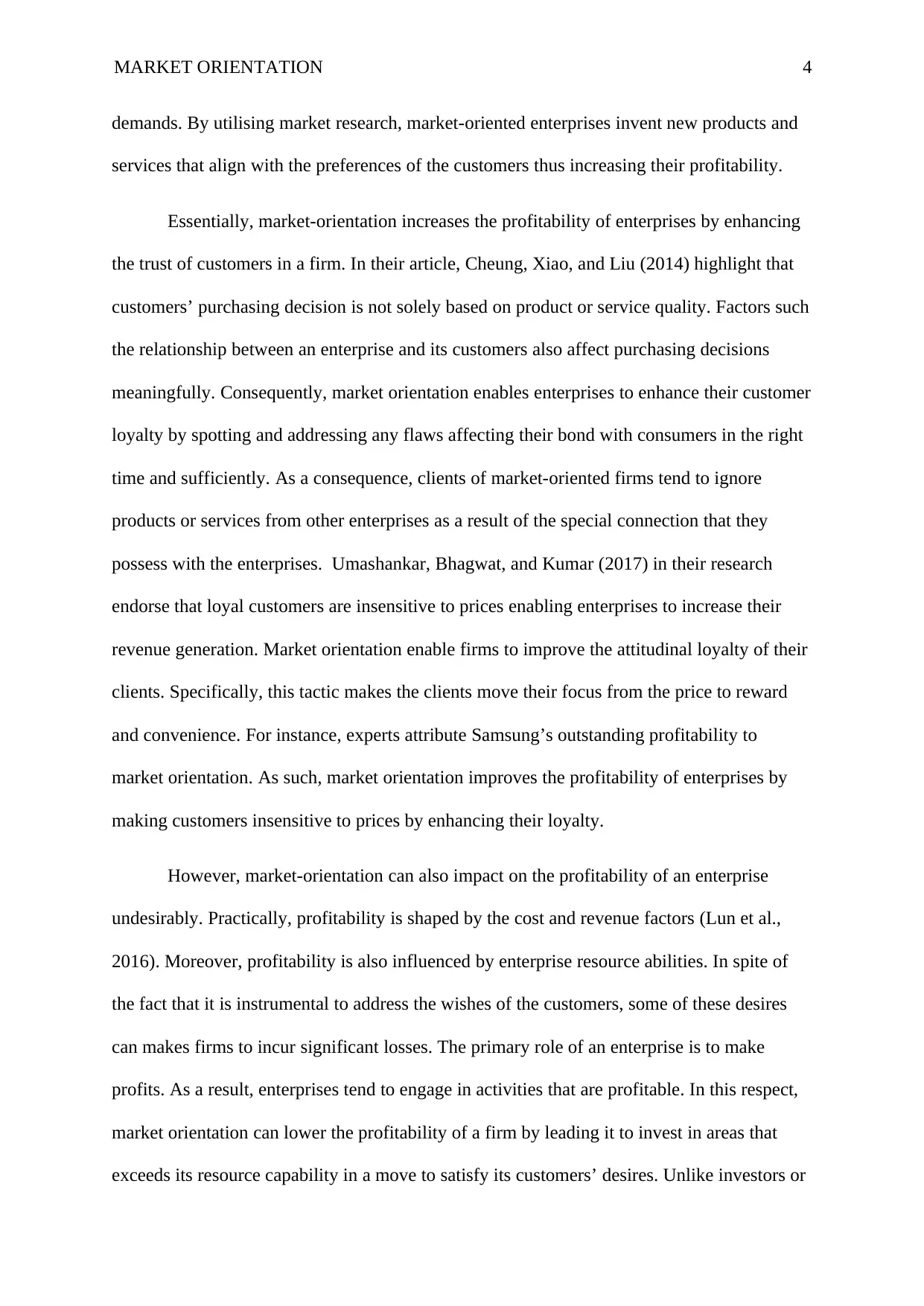
MARKET ORIENTATION 4
demands. By utilising market research, market-oriented enterprises invent new products and
services that align with the preferences of the customers thus increasing their profitability.
Essentially, market-orientation increases the profitability of enterprises by enhancing
the trust of customers in a firm. In their article, Cheung, Xiao, and Liu (2014) highlight that
customers’ purchasing decision is not solely based on product or service quality. Factors such
the relationship between an enterprise and its customers also affect purchasing decisions
meaningfully. Consequently, market orientation enables enterprises to enhance their customer
loyalty by spotting and addressing any flaws affecting their bond with consumers in the right
time and sufficiently. As a consequence, clients of market-oriented firms tend to ignore
products or services from other enterprises as a result of the special connection that they
possess with the enterprises. Umashankar, Bhagwat, and Kumar (2017) in their research
endorse that loyal customers are insensitive to prices enabling enterprises to increase their
revenue generation. Market orientation enable firms to improve the attitudinal loyalty of their
clients. Specifically, this tactic makes the clients move their focus from the price to reward
and convenience. For instance, experts attribute Samsung’s outstanding profitability to
market orientation. As such, market orientation improves the profitability of enterprises by
making customers insensitive to prices by enhancing their loyalty.
However, market-orientation can also impact on the profitability of an enterprise
undesirably. Practically, profitability is shaped by the cost and revenue factors (Lun et al.,
2016). Moreover, profitability is also influenced by enterprise resource abilities. In spite of
the fact that it is instrumental to address the wishes of the customers, some of these desires
can makes firms to incur significant losses. The primary role of an enterprise is to make
profits. As a result, enterprises tend to engage in activities that are profitable. In this respect,
market orientation can lower the profitability of a firm by leading it to invest in areas that
exceeds its resource capability in a move to satisfy its customers’ desires. Unlike investors or
demands. By utilising market research, market-oriented enterprises invent new products and
services that align with the preferences of the customers thus increasing their profitability.
Essentially, market-orientation increases the profitability of enterprises by enhancing
the trust of customers in a firm. In their article, Cheung, Xiao, and Liu (2014) highlight that
customers’ purchasing decision is not solely based on product or service quality. Factors such
the relationship between an enterprise and its customers also affect purchasing decisions
meaningfully. Consequently, market orientation enables enterprises to enhance their customer
loyalty by spotting and addressing any flaws affecting their bond with consumers in the right
time and sufficiently. As a consequence, clients of market-oriented firms tend to ignore
products or services from other enterprises as a result of the special connection that they
possess with the enterprises. Umashankar, Bhagwat, and Kumar (2017) in their research
endorse that loyal customers are insensitive to prices enabling enterprises to increase their
revenue generation. Market orientation enable firms to improve the attitudinal loyalty of their
clients. Specifically, this tactic makes the clients move their focus from the price to reward
and convenience. For instance, experts attribute Samsung’s outstanding profitability to
market orientation. As such, market orientation improves the profitability of enterprises by
making customers insensitive to prices by enhancing their loyalty.
However, market-orientation can also impact on the profitability of an enterprise
undesirably. Practically, profitability is shaped by the cost and revenue factors (Lun et al.,
2016). Moreover, profitability is also influenced by enterprise resource abilities. In spite of
the fact that it is instrumental to address the wishes of the customers, some of these desires
can makes firms to incur significant losses. The primary role of an enterprise is to make
profits. As a result, enterprises tend to engage in activities that are profitable. In this respect,
market orientation can lower the profitability of a firm by leading it to invest in areas that
exceeds its resource capability in a move to satisfy its customers’ desires. Unlike investors or
Paraphrase This Document
Need a fresh take? Get an instant paraphrase of this document with our AI Paraphraser
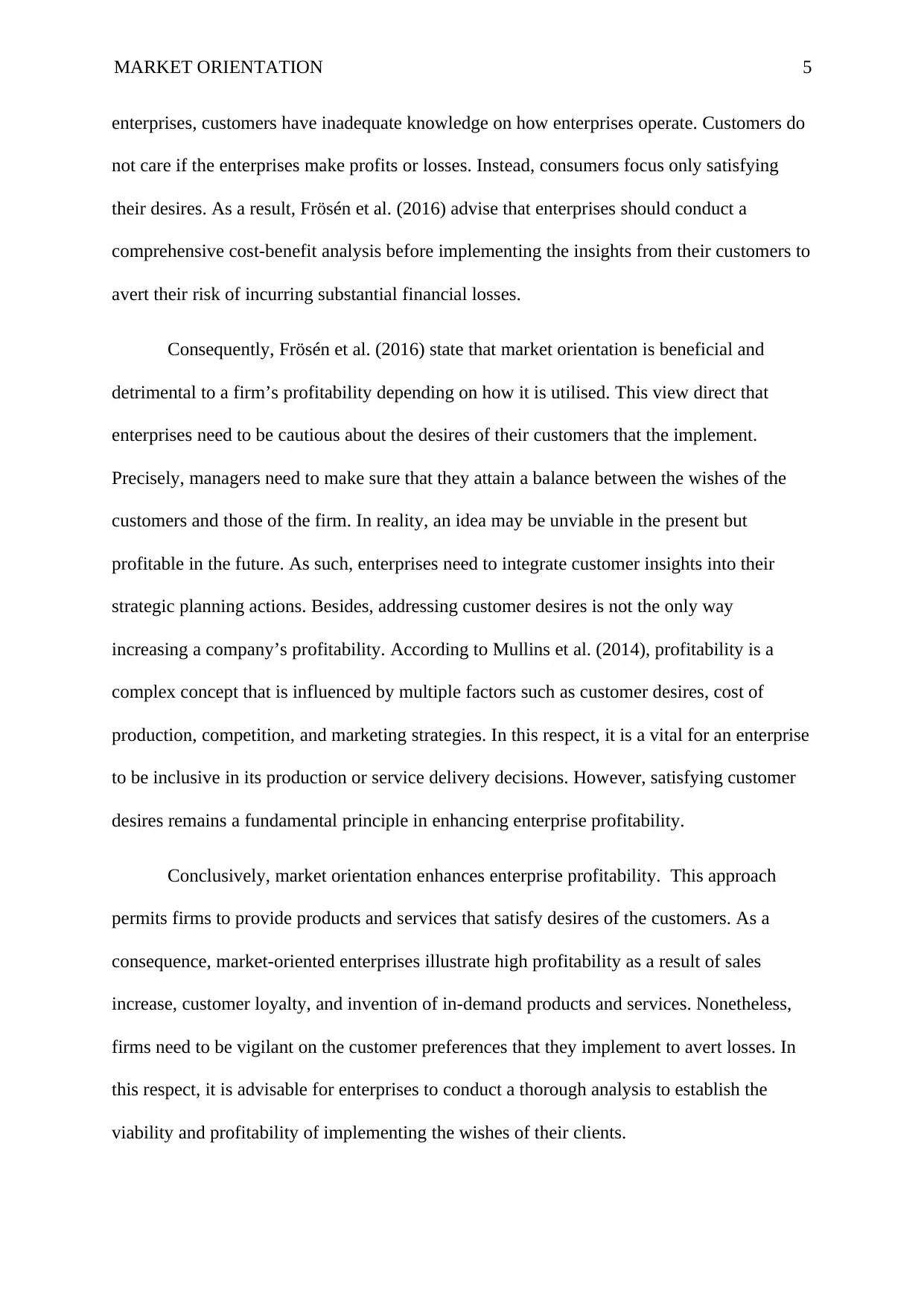
MARKET ORIENTATION 5
enterprises, customers have inadequate knowledge on how enterprises operate. Customers do
not care if the enterprises make profits or losses. Instead, consumers focus only satisfying
their desires. As a result, Frösén et al. (2016) advise that enterprises should conduct a
comprehensive cost-benefit analysis before implementing the insights from their customers to
avert their risk of incurring substantial financial losses.
Consequently, Frösén et al. (2016) state that market orientation is beneficial and
detrimental to a firm’s profitability depending on how it is utilised. This view direct that
enterprises need to be cautious about the desires of their customers that the implement.
Precisely, managers need to make sure that they attain a balance between the wishes of the
customers and those of the firm. In reality, an idea may be unviable in the present but
profitable in the future. As such, enterprises need to integrate customer insights into their
strategic planning actions. Besides, addressing customer desires is not the only way
increasing a company’s profitability. According to Mullins et al. (2014), profitability is a
complex concept that is influenced by multiple factors such as customer desires, cost of
production, competition, and marketing strategies. In this respect, it is a vital for an enterprise
to be inclusive in its production or service delivery decisions. However, satisfying customer
desires remains a fundamental principle in enhancing enterprise profitability.
Conclusively, market orientation enhances enterprise profitability. This approach
permits firms to provide products and services that satisfy desires of the customers. As a
consequence, market-oriented enterprises illustrate high profitability as a result of sales
increase, customer loyalty, and invention of in-demand products and services. Nonetheless,
firms need to be vigilant on the customer preferences that they implement to avert losses. In
this respect, it is advisable for enterprises to conduct a thorough analysis to establish the
viability and profitability of implementing the wishes of their clients.
enterprises, customers have inadequate knowledge on how enterprises operate. Customers do
not care if the enterprises make profits or losses. Instead, consumers focus only satisfying
their desires. As a result, Frösén et al. (2016) advise that enterprises should conduct a
comprehensive cost-benefit analysis before implementing the insights from their customers to
avert their risk of incurring substantial financial losses.
Consequently, Frösén et al. (2016) state that market orientation is beneficial and
detrimental to a firm’s profitability depending on how it is utilised. This view direct that
enterprises need to be cautious about the desires of their customers that the implement.
Precisely, managers need to make sure that they attain a balance between the wishes of the
customers and those of the firm. In reality, an idea may be unviable in the present but
profitable in the future. As such, enterprises need to integrate customer insights into their
strategic planning actions. Besides, addressing customer desires is not the only way
increasing a company’s profitability. According to Mullins et al. (2014), profitability is a
complex concept that is influenced by multiple factors such as customer desires, cost of
production, competition, and marketing strategies. In this respect, it is a vital for an enterprise
to be inclusive in its production or service delivery decisions. However, satisfying customer
desires remains a fundamental principle in enhancing enterprise profitability.
Conclusively, market orientation enhances enterprise profitability. This approach
permits firms to provide products and services that satisfy desires of the customers. As a
consequence, market-oriented enterprises illustrate high profitability as a result of sales
increase, customer loyalty, and invention of in-demand products and services. Nonetheless,
firms need to be vigilant on the customer preferences that they implement to avert losses. In
this respect, it is advisable for enterprises to conduct a thorough analysis to establish the
viability and profitability of implementing the wishes of their clients.
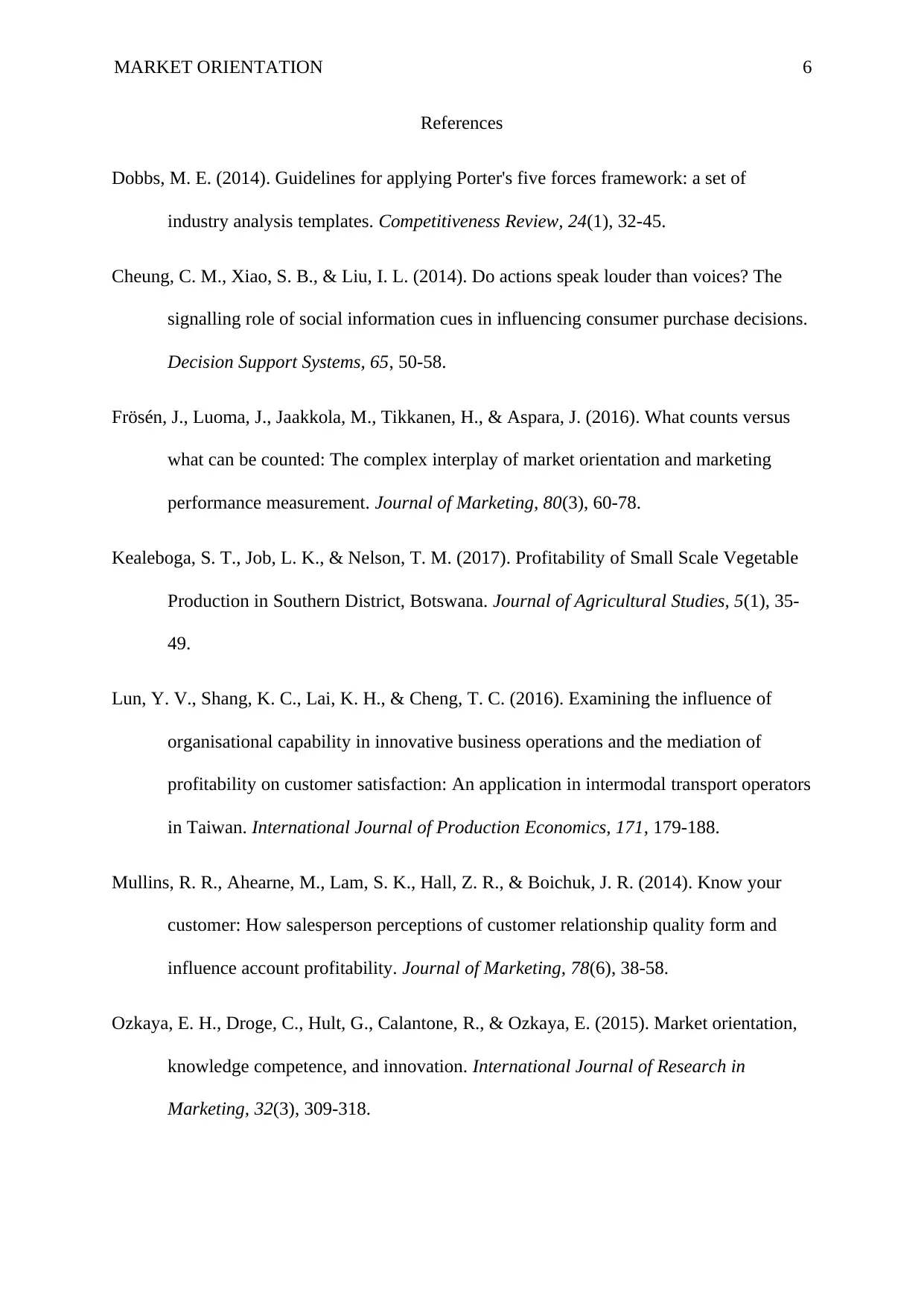
MARKET ORIENTATION 6
References
Dobbs, M. E. (2014). Guidelines for applying Porter's five forces framework: a set of
industry analysis templates. Competitiveness Review, 24(1), 32-45.
Cheung, C. M., Xiao, S. B., & Liu, I. L. (2014). Do actions speak louder than voices? The
signalling role of social information cues in influencing consumer purchase decisions.
Decision Support Systems, 65, 50-58.
Frösén, J., Luoma, J., Jaakkola, M., Tikkanen, H., & Aspara, J. (2016). What counts versus
what can be counted: The complex interplay of market orientation and marketing
performance measurement. Journal of Marketing, 80(3), 60-78.
Kealeboga, S. T., Job, L. K., & Nelson, T. M. (2017). Profitability of Small Scale Vegetable
Production in Southern District, Botswana. Journal of Agricultural Studies, 5(1), 35-
49.
Lun, Y. V., Shang, K. C., Lai, K. H., & Cheng, T. C. (2016). Examining the influence of
organisational capability in innovative business operations and the mediation of
profitability on customer satisfaction: An application in intermodal transport operators
in Taiwan. International Journal of Production Economics, 171, 179-188.
Mullins, R. R., Ahearne, M., Lam, S. K., Hall, Z. R., & Boichuk, J. R. (2014). Know your
customer: How salesperson perceptions of customer relationship quality form and
influence account profitability. Journal of Marketing, 78(6), 38-58.
Ozkaya, E. H., Droge, C., Hult, G., Calantone, R., & Ozkaya, E. (2015). Market orientation,
knowledge competence, and innovation. International Journal of Research in
Marketing, 32(3), 309-318.
References
Dobbs, M. E. (2014). Guidelines for applying Porter's five forces framework: a set of
industry analysis templates. Competitiveness Review, 24(1), 32-45.
Cheung, C. M., Xiao, S. B., & Liu, I. L. (2014). Do actions speak louder than voices? The
signalling role of social information cues in influencing consumer purchase decisions.
Decision Support Systems, 65, 50-58.
Frösén, J., Luoma, J., Jaakkola, M., Tikkanen, H., & Aspara, J. (2016). What counts versus
what can be counted: The complex interplay of market orientation and marketing
performance measurement. Journal of Marketing, 80(3), 60-78.
Kealeboga, S. T., Job, L. K., & Nelson, T. M. (2017). Profitability of Small Scale Vegetable
Production in Southern District, Botswana. Journal of Agricultural Studies, 5(1), 35-
49.
Lun, Y. V., Shang, K. C., Lai, K. H., & Cheng, T. C. (2016). Examining the influence of
organisational capability in innovative business operations and the mediation of
profitability on customer satisfaction: An application in intermodal transport operators
in Taiwan. International Journal of Production Economics, 171, 179-188.
Mullins, R. R., Ahearne, M., Lam, S. K., Hall, Z. R., & Boichuk, J. R. (2014). Know your
customer: How salesperson perceptions of customer relationship quality form and
influence account profitability. Journal of Marketing, 78(6), 38-58.
Ozkaya, E. H., Droge, C., Hult, G., Calantone, R., & Ozkaya, E. (2015). Market orientation,
knowledge competence, and innovation. International Journal of Research in
Marketing, 32(3), 309-318.
⊘ This is a preview!⊘
Do you want full access?
Subscribe today to unlock all pages.

Trusted by 1+ million students worldwide
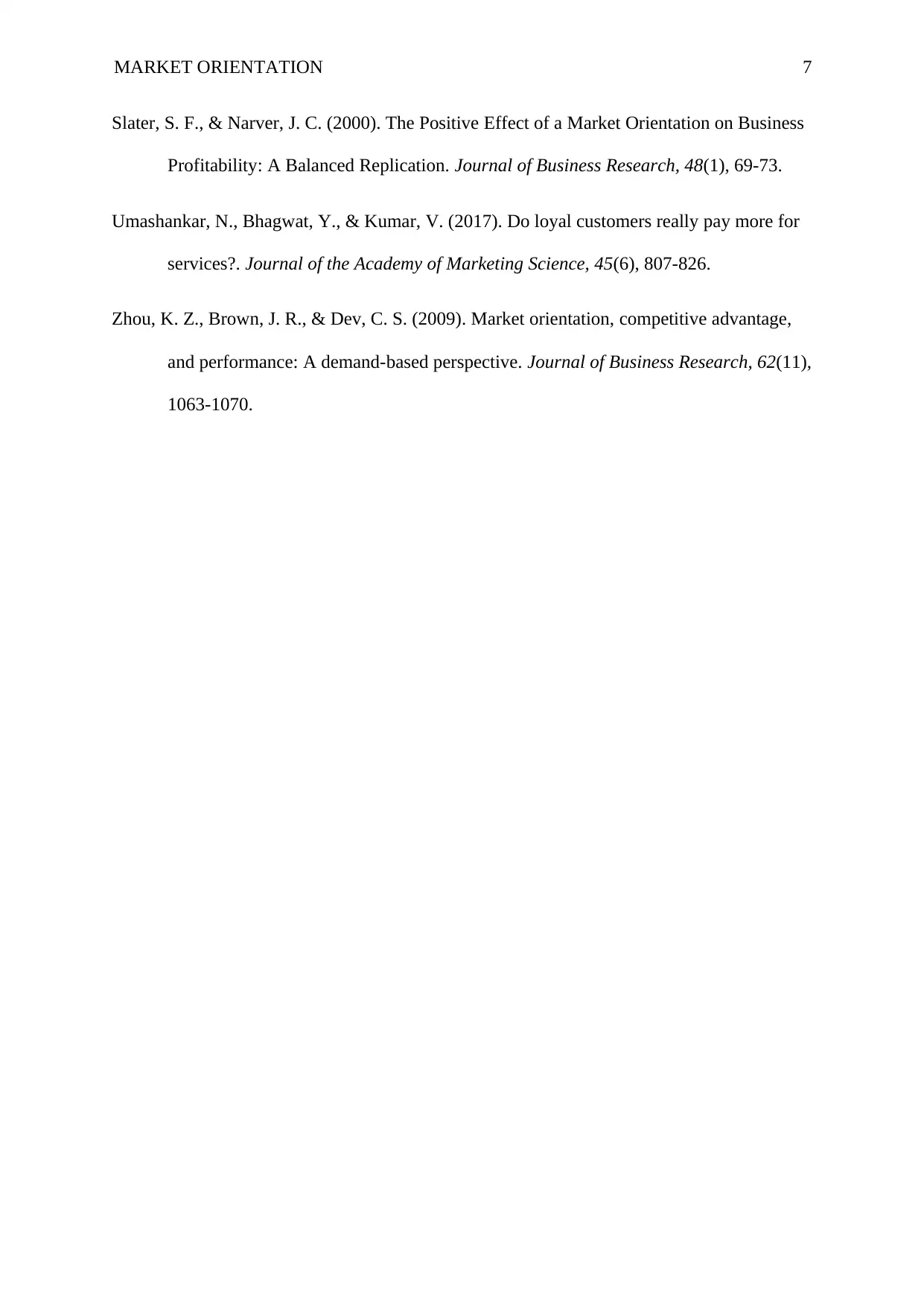
MARKET ORIENTATION 7
Slater, S. F., & Narver, J. C. (2000). The Positive Effect of a Market Orientation on Business
Profitability: A Balanced Replication. Journal of Business Research, 48(1), 69-73.
Umashankar, N., Bhagwat, Y., & Kumar, V. (2017). Do loyal customers really pay more for
services?. Journal of the Academy of Marketing Science, 45(6), 807-826.
Zhou, K. Z., Brown, J. R., & Dev, C. S. (2009). Market orientation, competitive advantage,
and performance: A demand-based perspective. Journal of Business Research, 62(11),
1063-1070.
Slater, S. F., & Narver, J. C. (2000). The Positive Effect of a Market Orientation on Business
Profitability: A Balanced Replication. Journal of Business Research, 48(1), 69-73.
Umashankar, N., Bhagwat, Y., & Kumar, V. (2017). Do loyal customers really pay more for
services?. Journal of the Academy of Marketing Science, 45(6), 807-826.
Zhou, K. Z., Brown, J. R., & Dev, C. S. (2009). Market orientation, competitive advantage,
and performance: A demand-based perspective. Journal of Business Research, 62(11),
1063-1070.
1 out of 7
Related Documents
Your All-in-One AI-Powered Toolkit for Academic Success.
+13062052269
info@desklib.com
Available 24*7 on WhatsApp / Email
![[object Object]](/_next/static/media/star-bottom.7253800d.svg)
Unlock your academic potential
Copyright © 2020–2025 A2Z Services. All Rights Reserved. Developed and managed by ZUCOL.





